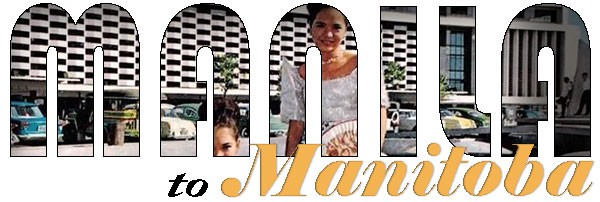 There doesn’t seem like there’s much to Winnipeg’s Chinatown.
There doesn’t seem like there’s much to Winnipeg’s Chinatown.
Aside from the beautiful Dynasty Building on King Street, the famed corner of Winnipeg’s downtown is but a scattering of old (derelict) buildings with a handful of faded Chinese store signs. Visitors can’t expect the same hustle and bustle found in Vancouver or Toronto’s Chinatowns. Instead, it’s pretty quiet. Sure there are customers coming and going for dim sum and Chinese food in one of the area’s many restaurants, but other than that Winnipeg’s Chinatown is unequivocally tame. There are no outdoor markets. There are no artisans selling their ware. Sure, Mandarin is still spoken, but odds are you’re likely to hear others speak in Tagalog as well.
If the Filipino-Canadian community were to ever have its own quarter, like how the Chinese have a portion of downtown, what would it look like? Where would it be? There is much we can learn from the Chinese community in Winnipeg to reflect on these questions. This blog post will explain why I think Winnipeg doesn’t need an official Filipino-town.
The Chinese-Canadian community in Winnipeg is well over a century in age. Throughout the 1800s, Chinese workers were needed to build the Canadian Pacific Railway across the country. In 1885, when the last rail spike was driven in BC, the Canadian government had no use for these migrant workers anymore and implemented an aptly named “Chinese head tax” to curb any further immigration. Without work and without pay, thousands of Chinese workers were left to return to China or eek out a living in Canada. In 1877, Winnipeg became home to its very first Chinese settlers, 3 men in search of work. By 1901, Manitoba census reported 206 Chinese males living throughout the province.
Chinatown developed in Winnipeg because Chinese settlers had little else to go. They were relegated to the fringes of the city centre, on cheap undesirable land, on a portion of the city where their meagre earnings as laundrymen could afford. Here they grouped together enriched by their social capital, where a shared language, culture, and race brought them new wealth as an enclave. Winnipeg’s Chinatown peaked in the 1920s to span 6 city blocks along King St, the area’s economic lane. There were 900 Chinese residents then and 300 Chinese laundry businesses. But by 1923, upon Canada’s Exclusion Act, the decline of Chinatown was eminent with a formal end to Chinese immigration.
The Chinatown we see in Winnipeg today is a mix of efforts to revive the area. In the 1980s, Winnipeg developed a “clean slate” strategy which consisted of a “demolish and rebuild” style of top-down renewal according to Architect Brent Bellamy. However, efforts from the Chinese community itself, namely through its leaders Dr. Joseph Du and Philip Lee (now our Lieutenant Governor), encouraged the Chinese community to reach outward and promote its culture. The Dynasty Building, the Chinese Heritage Garden, Chinatown Arch, and King Street beautification project, and the Peace Tower Apartment Complex represent their efforts in the early 90s. Winnipeg’s ethnic Chinese population is estimated today to be more than 20 thousand.
So what can we learn from Winnipeg’s Chinese Community?
I’ve heard talk time and again about a possible Filipino-town in Winnipeg. I imagine it would have small lamp post signage to mark territories along Isabel, Sargent, Ellice, or maybe Keewatin. It would capitalize on the fact that in those areas of the city there exist a number of Filipino businesses, bakeries, and stores. It would mark a cute little tourist stop where Filipino entrepreneurs chose to open up shop where people can come to buy some ube cake or get a nice hair cut. It would be a marker to point where Filipino people supposedly live. To me, I think that’s all it would be – another superficial stop on the Winnipeg tourist map.
Winnipeg’s Filipino-Canadian community is just over 50 years in age. We began to arrive in the late 1950s first as medical professionals and later as garment workers, nurses, and sponsored relatives towards the 1970s and 1980s. Overall, we came in time for Trudeau and his multiculturalism banner; in time to by-pass all the ugliness of head taxes and exclusion acts made specifically for the Chinese.
The Filipino-Canadian community in Winnipeg exists throughout the city. I don’t deny the fact that a large majority of Filipino-Canadians live in the northwest corner of the city where the Tyndall, Maples, and Garden City neighbourhoods exist. I only underline the importance of noting that Filipino-Canadians are able to choose which area of the city they wish to live. That is the important lesson we can learn from Winnipeg’s Chinatown.
I believe the growth, decline, and process of re-emergence for Winnipeg’s Chinatown is testament to their difficult history as Canadians. They were pushed to create their own businesses and homes on areas the rest of society deemed undesirable. Their community has changed in size from immigration acts to limit their number and to today where any growth appears in tandem with Chinatown’s unusual silence. To learn of how Winnipeg’s Chinatown came into existence and the struggles it has endured to maintain its post, a Filipino-town would lack any of the same historical significance or interest if it ever were to happen. If a Filipino-town were ever to belong in Winnipeg, it too should reflect its history as a community. Our history falls under the 1960s banner of “multiculturalism” and our place exists scattered throughout Winnipeg.
Sources:
Brent Bellamy. “A Vibrant Vision for Chinatown: Thesis project sees blend of new, historic marketplace,” WFP 4/29/13
Larry Kursch. “Hard-working Chinese immigrants, once banned, have risen to the highest echelons of Manitoba,” WFP 7/28/12
 There doesn’t seem like there’s much to Winnipeg’s Chinatown.
There doesn’t seem like there’s much to Winnipeg’s Chinatown. 

